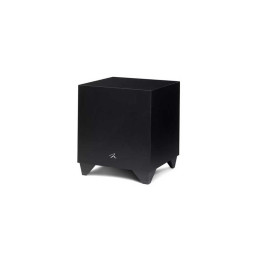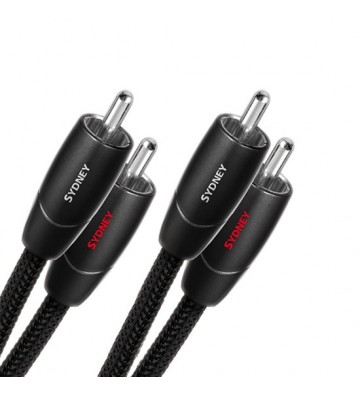AudioQuest Red River RCA Cable
Connect audio source components to amplifiers and receivers with the AudioQuest Red River RCA Cable.
Meticulously designed for exceptional performance and outstanding value. Solid Perfect-Surface Copper+ (PSC+) conductors minimize distortion, Foamed-Polyethylene insulation preserves dynamic contrasts, and a Metal-Layer Noise-Dissipation efficiently dissipates high-frequency noise.
The result is cleaner, clearer, more naturally beautiful music.
Features
- Solid conductors prevent strand-interaction, a major source of dynamic distortion in cables.
- AudioQuest’s best copper. To the greatest extent presently possible, extreme-purity Perfect-Surface Copper+ (PSC+) conductors minimize distortion caused by grain boundaries.
- Metal-Layer Noise-Dissipation shields noise effectively, absorbing and reflecting most RFI before it reaches the ground layer.
- Hard-Cell Foamed-Polyethylene’s high air content minimizes energy absorption for clearer sound.
- All conductors controlled for RF-noise directionality.
Solid Perfect-Surface Copper (PSC) Conductors
Since the beginning, AudioQuest has pioneered the use of superior metals, yet even we were surprised by the huge leap in performance attained through the astonishingly smooth and pure surface of Perfect-Surface Copper (PSC).
Proprietary metal-processing technology protects the wire’s surface at every stage of drawing and fabrication. When high-purity low-oxide copper is kept as soft, pure, and smooth as possible, it becomes a wonderfully low-distortion conductor.
In a conventional cable, electrical and magnetic interaction between strands is one of the greatest sources of distortion, often causing a somewhat harsh, dirty sound.
Solid conductors are fundamental toward achieving a very clean, natural sound.
Direction-Controlled Conductors
All drawn metal strands or conductors have a non-symmetrical, and therefore directional, grain structure.
AudioQuest controls the resulting RF impedance variation so that noise is drained away from where it will cause distortion. The correct direction is determined by listening to every batch of metal conductors used in every AudioQuest audio cable. When applicable, arrows are clearly marked on the connectors to ensure superior sound quality.
For most models of AQ cable, the arrows not only indicate the direction that optimizes metal-directionality as part of Noise-Dissipation, but also indicates non-symmetrical attachment of shield and GND in order to optimize full-system performance.
A fundamental aspect of AudioQuest’s multifaceted Noise-Dissipation technology, Direction-Controlled Conductors ensure induced noise is dissipated and drained properly.
Metal-Layer Noise-Dissipation
It’s easy to accomplish 100% shield coverage.
Preventing captured radio-frequency interference (RFI) from modulating the equipment’s ground reference requires AQ’s Noise-Dissipation.
Traditional shield systems typically absorb and then drain noise/RF energy to component ground, modulating and distorting the critical “reference” ground plane, which in turn causes a distortion of the signal.
Noise-Dissipation “shields the shield,” absorbing and reflecting most of this noise/RF energy before it reaches the layer attached to ground.
Hard-Cell Foam Insulation
Hard-Cell Foam (HCF) Insulation ensures critical signal-pair geometry. Any solid material adjacent to a conductor is actually part of an imperfect circuit. Wire insulation and circuit board materials all absorb energy. Some of this energy is stored and then released as distortion.
Hard-Cell Foam Insulation is similar to the Foamed-PE used in our more affordable Bridges & Falls cables, and is nitrogen-injected to create air pockets. Because nitrogen (like air) does not absorb energy and therefore does not release any energy from or into the conductor, distortion is reduced.
In addition, the stiffness of the material allows the cable’s conductors to maintain a stable relationship along the cable’s full length, producing a stable impedance character and further minimizing distortion.
Triple-Balanced Geometry
Our Triple-Balanced Geometry uses a separate ground-reference conductor, so the cable’s shield is never used as an inferior conductor. Whether prepared with RCA or XLR plugs, the cable’s three conductors ensure that the positive and negative signals have equally superior, low-distortion conducting paths.
Cold-Welded, Gold-Plated Terminations
This plug design allows for a connection devoid of solder, which is a common source of distortion. Instead of solder, the process employs a high-pressure technique. Because the ground shells are stamped instead of machined, the metal used can be chosen for low distortion instead of machinability.
Specifications
| Metal | Solid Perfect-Surface Copper (PSC) |
| Noise Dissipation | Metal-Layer |
| Geometry | Triple-Balanced |
| Insulation | Foamed-Polyethylene |
| Terminations | Gold-Plated |
| Signal Type | Analog |
| Cable Length | Various |
| Jacket | Red on Black Braid |
| Sold As | Pair – 2 Individual Cables |
| Weight | 0.5 lb |





















